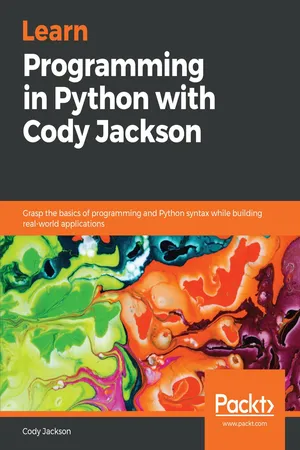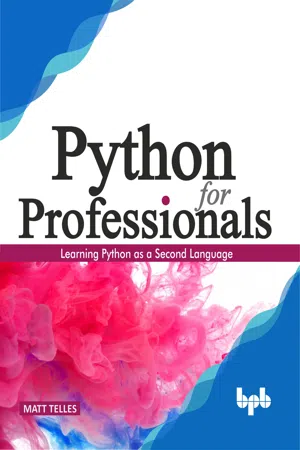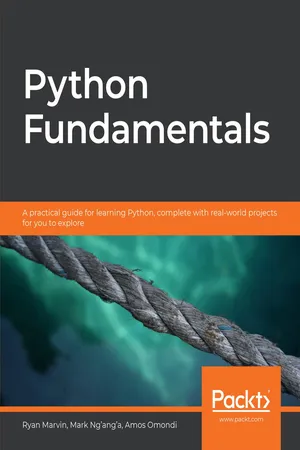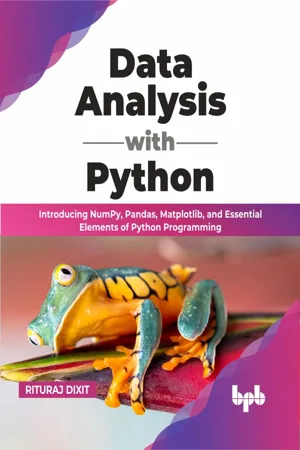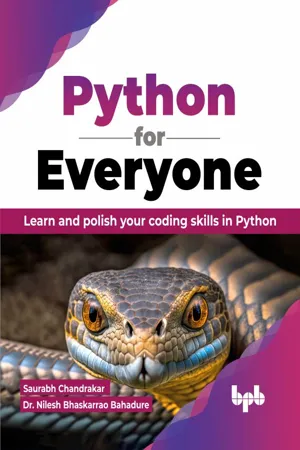Computer Science
Python Data Types
Python data types refer to the different categories of data that can be used in Python programming. These include fundamental types like integers, floats, and strings, as well as more complex types like lists, tuples, dictionaries, and sets. Understanding data types is crucial for effectively manipulating and organizing data within Python programs.
Written by Perlego with AI-assistance
Related key terms
10 Key excerpts on "Python Data Types"
- eBook - ePub
- Kuldeep Singh Kaswan, Jagjit Singh Dhatterwal, B Balamurugan(Authors)
- 2023(Publication Date)
- Chapman and Hall/CRC(Publisher)
The second output line uses commas as separators. The third line runs the items together with an empty string separator. The fifth line shows that the separating string may consist of multiple characters. 2.9 Conclusion Data type in Python is a crucial term in programming. Variables can store a variety of data, and different data types can perform different tasks. A data type, also referred to as type, is a property of data that informs the interpreter or compiler about how the programmer intends to use the available information. The categorization or grouping of data objects is known as data forms. This denotes the type of value that determines which operations can be performed on a given collection of data. Data types are simply classes, and variables are instances (objects) of these classes, since everything in Python programming is an entity. - eBook - ePub
Learn Programming in Python with Cody Jackson
Grasp the basics of programming and Python syntax while building real-world applications
- Cody Jackson(Author)
- 2018(Publication Date)
- Packt Publishing(Publisher)
Like many other programming languages, Python has built-in data types that the programmer uses to create a program. These data types are the building blocks of the program. Depending on the language, different data types are available. Some languages, notably C and C++, have very primitive types; a lot of programming time is spent simply combining these primitive types into useful data structures.Python does away with a lot of this tedious work. It already implements a wide range of types and structures, leaving the developer more time to actually create the program. Having to constantly recreate the same data structures for every program is not something to look forward to.Python has the following built-in types:- Numbers
- Strings
- Lists
- Dictionaries
- Tuples
- Files
- Sets
- Databases
In addition, functions, modules, classes, and implementation-related types are also considered built-in types, because they can be passed between scripts, stored in other objects, and otherwise treated like the other fundamental types.Naturally, you can build your own types if needed, but Python was created so that very rarely will you have to roll your own. The built-in types are powerful enough to cover the vast majority of your code and are easily enhanced.It was mentioned previously that Python is a dynamic typed language; that is, a variable can be used as an integer, a float, a string, or whatever. Python will determine what is needed as it runs. The following screenshot shows how variables can be assigned arbitrarily. You can also see that it is trivial to change a value, as shown in line 16:Dynamic typingOther languages often require the programmer to decide what the variable must be when it is initially created. For example, C would require you to declare x in the preceding program to be of type int and y to be of type string. From then on, that's all those variables can be, even if, later on, you decide that they should be a different type.That means you would have to decide what each variable will be when you started your program; that is, deciding whether a number variable should be an integer or a floating-point number. Obviously, you could go back and change them at a later time, but it's just one more thing for you to think about and remember. Plus, any time you forgot what type a variable was and you tried to assign the wrong value to it, you would get a compiler error. - eBook - ePub
Python for Professionals
Learning Python as a Second Language
- Matt Telles(Author)
- 2019(Publication Date)
- BPB Publications(Publisher)
HAPTER 2Python Types and Constructs
Introduction
Every discussion of programming begins with looking at the types of values that you can store, along with the ways in which you can work with those variables. Python, and this book, is no exception to the rule. In this chapter, we'll start out by looking at the various types of data that can be used in Python, and how you can use them. We'll explore how to convert from one to another, how to build enumerable types such as lists and sets, and how Python expects things to be created.Data types, of course, are the building blocks that make up a language. Surprisingly, Python has fewer of them than most, because it does much more with them.Structure
- Data types
- Iterators and iterables
- Classes and objects
- Booleans and truthyness
Objectives
In this chapter, you will learn about the various data types in Python, from simple types like integers and floats to more complex types like classes and collections. You will explore the concept of iterators and iterables, of booleans and truthyness, a truly Pythonesque concept. We will talk a little about complex numbers, a difficult math concept made simple in Python. Finally, we'll talk about that standard of programming, commenting.Integers
The most basic numeric type is the integer. Integers are whole numbers with no fractional portion. In most languages, there are numerous types of integers, representing very small numbers, like bytes, up to very large numbers, like long integers, or even long long values. Instead, Python uses a single integer type, which is fixed precision, allowing it to store any value up to available machine memory. That is to say, we can have a single variable, myInt - eBook - ePub
Programming in Python
Learn the Powerful Object-Oriented Programming
- Dr. Pooja Sharma(Author)
- 2018(Publication Date)
- BPB Publications(Publisher)
HAPTER 5Python Native Data Types
Highlights
- Python native data types
- Number
- List, tuple, set, dictionary
- Strings
As described in Chapter 2 , Python language supports different data types to handle various sort of data. Here in this chapter, we describe the following Python native data types in detail.Number: represents numeric data to perform mathematical operations.String: represents text characters, special symbols or alphanumeric data.List: represents sequential data that the programmer wishes to sort, merge, etc.Tuple: represents sequential data with a little difference from list.Set: is used for performing set operations such as intersection, difference, etc with multiple values.Dictionary: represents a collection of data that associate a unique key with each value.5.1. Number
Number is an object in Python, and it is created when some value is assigned to it. Number data type is used to hold numerical data. Python language supports four different numeric data types as described below:- int (signed integers) : Alike C/C++/Java, Python supports integer numbers, which are whole numbers positive as well as negative having no decimal point.
- long (long integers) : Similar to integers but with limitless size. In Python long integers are followed by a lowercase or uppercase L.
- float (floating point real values) : Alike C/C++/Java, Python supports real numbers, called as floats. These number are written with a decimal point or sometimes in a scientific notation, with exponent e such as 5.9e7 i.e. 5.9x107, where e represents the power of 10.
- complex (complex numbers) : Unlike C/C++/Java, Python supports complex data type. It holds complex numbers of the form x+iy, where x and y are floating point numbers and i is iota representing the square root of -1 (imaginary number). Complex numbers have two parts where x is known as the real part and y is called the imaginary part as it is with iota.
Unlike C/C++/Java,in Python the variable declaration is not mandatory. The programmer just assign the value to a variable and that variable exists with the data type based on the value assigned. For example, the Code 5.1 - eBook - ePub
Python Fundamentals
A practical guide for learning Python, complete with real-world projects for you to explore
- Ryan Marvin, Mark Ng'ang'a, Amos Omondi(Authors)
- 2018(Publication Date)
- Packt Publishing(Publisher)
2Data Types
Learning Objectives
By the end of this chapter, you will be able to:- Explain the different numerical data types
- Use operators on numerical data types
- Explain strings and implement string operations, such as indexing, slicing, and string formatting
- Describe escape sequences
- Explain lists and perform simple operations on them
- Use Boolean expressions and Boolean operators
Introduction
In the previous chapter, we learned about variables and looked at a few of the values/types of data that can be assigned to them. Specifically, we dealt with data of the string and integer types. In this chapter, we will look at the other data types that Python supports. Data types classify data, to tell the interpreter how the program intends to utilize that data. Data types define the different operations that can be performed on the data, how the data is stored, and the meaning of the data.Numerical Data
Let's begin with numerical data types.Types of Numbers
IntegersIntegers, as we saw in the previous chapter, are numerical data types that are comprised of whole numbers. Whole numbers can be either negative or positive. In the following example, we will see how Python represents integers, and then, we can check their types:>>> integer = 49 >>> negative_integer = -35 >>> print(type(integer), integer) <class 'int'> 49 >>> print(type(negative_integer), negative_integer) <class 'int'> -35 >>> Additionally, Python integers have unlimited precision. This means that there are no limits to how large they can be (save for the amount of available memory): >>> large_integer = 34567898327463893216847532149022563647754227885439016662145553364327889985421 >>> print(large_integer) 34567898327463893216847532149022563647754227885439016662145553364327889985421 >>> Floating Point NumbersAnother numerical type supported by Python is floating point numbers. The type for this kind of value is float - Yasha Hasija, Rajkumar Chakraborty(Authors)
- 2021(Publication Date)
- CRC Press(Publisher)
2Basic Python ProgrammingIn this chapter, we will go through a basic understanding and overview of Python programming which is a prerequisite for any form of data analysis. Variables and operator, string, list and tuples, dictionary, conditions, loops, functions, and objects are some of the topics covered in this chapter.Let us begin with a familiar syntax in Python which is used for commenting a statement. If a statement or a line begins with “#”, then Python will ignore it. Comments are useful to make any code self-explanatory. We will use a lot of comments wherever required to make the code more understandable to readers.Code:#Let’s print “Hi there!” print('Hi there!')Output:Hi there!After executing the above code in the Jupyter Notebook by pressing “ctrl + enter”, the first statement or line starting with “#” will be ignored, and as a result, we will see “Hi there!”. Therefore, the first line is a comment which describes that the code will print “Hi there!”.Datatypes and Operators
Datatypes
As the name suggests, datatypes are the different types of data, such as numbers, characters, and Booleans that can be stored and analyzed in Python. Among various datatypes, the four most common are:• int (integers or whole numbers)• float (decimal numbers or floating-points)• bool (Boolean or True/False)• str (string or a collection of characters like a text)There are two important ways in which Python represents a number: int and float. Decimals numbers (float), such as 1.0, 3.14, ‒2.33, etc., will potentially consume more space than integers or whole numbers, like 1, 3, ‒4, 0, etc. Think of this way, if we take whole numbers between 0 and 1, then we will see only the two numbers 0 and 1, but, in the case of decimal numbers, we will get infinite numbers between 0.0 and 1.0. Next, we have a Boolean datatype, which is “True” or “False”, and these are used in making conditions which we will learn shortly. Lastly, “str” or the string datatype is the datatype that biologists will need and encounter the most - whether it is the DNA, RNA, and/or protein sequences or names, most of them are text or strings. Therefore, we have a separate section for strings in this chapter. It is imperative to mention here that string-type data always remains inside quotes, i.e. (‘<string data>’). For example, ‘ATGAATGC’ will be a string for Python.- eBook - ePub
Data Analysis with Python
Introducing NumPy, Pandas, Matplotlib, and Essential Elements of Python Programming (English Edition)
- Rituraj Dixit(Author)
- 2022(Publication Date)
- BPB Publications(Publisher)
HAPTER 3Operators and Built-in Data Types
I n the last chapter, we demonstrated how to install and run Anaconda and Jupyter notebook to develop and execute a Python program. In this chapter, we are going to learn about operators and built-in data types in Python. Operators and data types are necessary elements of any programming language. Data types are essential to store and retrieve the values in a program.Structure
In this chapter, we will discuss the following topics:- Variables in Python
- Operators in Python
- Built-in data types in Python
- Lists
- Tuples
- Sets
- Dictionaries
Objectives
After studying this chapter, you will be able to:- Define a variable in Python
- Use appropriate data types in the Python program
- Work with a list, a tuple, sets, and a dictionary in Python
Variables in Python?
A variable is the name of a reserved memory location that holds some value.For example: Let’s take a = 10. Here, ‘a’ is the variable name, the equal sign (=) is an assignment operator, and 10 is the value or literal. So, by using an assignment operator (=) in Python, we can reserve memory for value without explicitly declaring it.Rules for defining a variable name in Python
- A variable name must begin with a letter or underscore (_); it cannot start with a number.
- It can contain only (A-Z, a-z, 0-9, and _ ).
- In Python, variable names are case-sensitive.
Operators in Python
To perform operations, we need operators, which are the function of the operation, and operands are the input to that operation. For example, 10+6 = 16; here, in this expression, 10 and 6 are the operands, and + is the operator.Various types of operators in Python are depicted with their implementation in Python as follows.Arithmetic operators
Arithmetic operators are required to perform arithmetic operations like addition, subtraction, multiplication, division, and so on. The following table is the list of arithmetic operators in Python: - eBook - ePub
Python Programming for Linguistics and Digital Humanities
Applications for Text-Focused Fields
- Martin Weisser(Author)
- 2023(Publication Date)
- Wiley-Blackwell(Publisher)
3 Programming Basics IIIn this chapter, we want to explore the remaining programming basics, which will already allow us to perform far more interesting language‐related tasks than simply dealing with individual words. To achieve this aim, we first need to learn something about the more complex‐structured compound data types Python offers. Next, rather than always ‘hard‐coding’ values for our variables inside our programs, we want to discover basic forms of interacting with our programs and/or users through collecting input from the command line to enable you to create basic tests or perform interactive exploration of data. Following this, we'll develop some ideas about how to solve simple to slightly more complex problems in programming, as well as avoid some of the most basic errors. Last, but not least, we'll find out about making decisions regarding the way our programs should proceed, e.g. in choosing relevant output, or to repeat specific steps with different parts or types of our data.3.1 Compound Data Types
The simple data types we looked at in the last chapter can only contain a single value, but of course the constructs we need to deal with while processing language aren't generally as simple as individual words only. And although we can easily store a complete text, such as a whole poem, play, article, or book inside a single string variable, generally we don't want to treat these texts in such a ‘holistic’ fashion. Instead, we want to be able to split them into their individual hierarchical parts, such as sections, chapters, paragraphs, sentences, or words, to be analysed separately and usually also retain some information about the order they appear in. Likewise, linguistic ‘objects’ of interest don't only exist at or above the level of words, but may also constitute parts thereof, such as affixes or even individual letters that we might want to manipulate or quantify. - eBook - ePub
Python for Everyone
Learn and polish your coding skills in Python (English Edition)
- Saurabh Chandrakar, Dr. Nilesh Bhaskarrao Bahadure(Authors)
- 2023(Publication Date)
- BPB Publications(Publisher)
HAPTER 7Concept of Data Structures in Python
Introduction
A way of organizing and storing data in order such that it can be accessed and modified efficiently, iscalled data structures. There is always a provision for data structures in every programming language. We have seen some primitive data types such as strings, integers, Boolean and float. Now, we will study some non-primitive inbuilt data structures such as list, tuple, set, dictionary, files and arrays. Each of these data structures are unique on its own. These data structures are an indispensable part in programming. Without these data structures, we cannot think of writing any Python program. Let us see some of these data structures one by one.Structure
In thischapter, we will discuss the following topics:- List data structure
- Tuple data structure
- Set data structure
- Dictionary data structure
Objectives
By the end of thischapter, the reader will have an idea about 4 data structures, viz, list, tuple, set and dictionary creation, as well as the elements accessing using indexing and slicing except for set, list, set, and dictionary comprehension using for loops, if /if-else /nested if statement. We shall also see which data structures are mutable, whose insertion order is preserved, and whose heterogenous objects are allowed with a Python snippet code.List data structure
A list can store different types of elements. It represents a group of elements; heterogeneous objects are allowed. List is dynamic as the size can be increased or decreased based on our requirement. We can modify the element in a list as it is mutable. Here, duplicate objects are allowed. In lists, the insertion order is preserved by using index. Duplicate elements are differentiated by using index in list. So, index play a vital role. All the elements in a list are separated by comma and are placed within square brackets. So, whenever there is a requirement to represent a group of individual objects as a single entity where we need to preserve the insertion order and duplicate objects are allowed, we should go for lists. - eBook - ePub
Python Networking Solutions Guide
Leverage the Power of Python to Automate and Maintain your Network Environment (English Edition)
- Tolga Koca(Author)
- 2023(Publication Date)
- BPB Publications(Publisher)
print function:a= 10 b= "Hello World" print ( type( a ) ) print ( type( b ) ) Output:<class ' int'><class 'str'>The most common data types that we use in network automation are string, integer, list, dictionary, and range. In addition to these data types, we have float, complex, tuple, set, and frozenset data types and more. These are also used in Python programming, but we rarely used them in our network automation scripts:- Text sequence : String
- Numeric types : Integer, Float, Complex
- Sequence types : List, Tuple and Range
- Mapping type : Dictionary
- Set types : Set, Frozenset
- Boolean operations : And, Or, Not
- Binary sequence types : Bytes, Bytearray, Memoryview
- String : It’s a simple text data type. x = "Hello World"
- Integer : It’s used for positive and negative integer numbers (…, -1, -2, 0, 1, 2, …) x = 52
- Float : It’s used for float numbers. x = 3.6
- List : It’s used to store multiple values or data in a single variable. Each item can be any kind of data type. Strings and numeric data types can only store one value inside a variable. x = [ "cat", "dog", "bird" ]
- Tuple : It’s similar to a list. We will check the difference in the comparison chart later in this chapter. Instead of square brackets in the list, we use parentheses for tuples. x = ( "cat", "dog", "bird" )
- Dictionary : We can store multiple items in a dictionary as mapping data types. We have keys and values that are attached together in an item. x = { "Animal" : "Bird", "type" : "Parrot", "color" : "Red" }
- Set : It has features similar to those of lists. They are created with unordered items and immutable data types. x = { "cat", "dog", "bird" }
Index pages curate the most relevant extracts from our library of academic textbooks. They’ve been created using an in-house natural language model (NLM), each adding context and meaning to key research topics.

